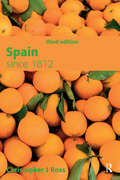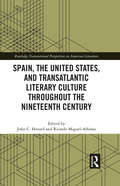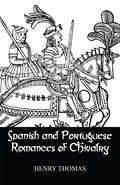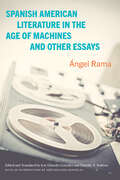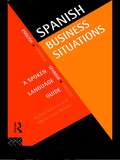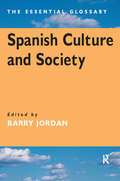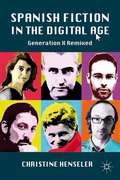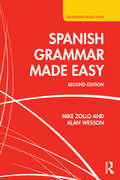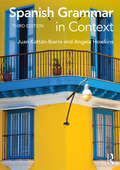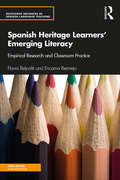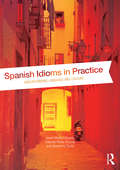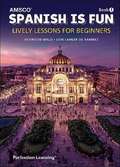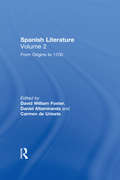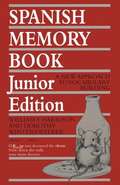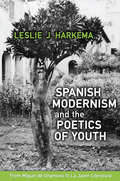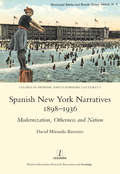- Table View
- List View
Spain since 1812
by Christopher RossSpain since 1812 is an ideal introduction to the history of Spain. The chapters are arranged chronologically and each begins with an overview of major events and movements in Europe as a whole. Emphasis is placed on understanding major developments, their causes, and the relationships between them. Spanish terms associated with key concepts and figures are introduced and explained throughout the text. Extracts from key Spanish texts, in Spanish and in translation, enable students to see, first hand, the mood of the time. Chapters end with topics for discussion to encourage critical thinking. This new edition has been revised and updated to take account of events since the Socialists' return to power in 2004. It looks at the new government's social reforms, its attempts to end ETA's violence and its response to Catalan demands for further autonomy. Also considered are changes in the country's political climate and external relationships, as well as the crisis facing Spain's economy. Written in an accessible style and assuming no prior knowledge, the books in this series address the specific needs of students on language courses, as well as anyone with an interest in modern history. Approaching the study of history via contemporary politics and society, each book offers a clear historical narrative and sets the country or region concerned in the context of the wider world.
Spain, the Second World War, and the Holocaust: History and Representation (Toronto Iberic)
by Gina Herrmann Sara J. BrenneisSpain has for too long been considered peripheral to the human catastrophes of World War II and the Holocaust. This volume is the first broadly interdisciplinary, scholarly collection to situate Spain in a position of influence in the history and culture of the Second World War. Featuring essays by international experts in the fields of history, literary studies, cultural studies, political science, sociology, and film studies, this book clarifies historical issues within Spain while also demonstrating the impact of Spain's involvement in the Second World War on historical memory of the Holocaust. Many of the contributors have done extensive archival research, bringing new information and perspectives to the table, and in many cases the essays published here analyze primary and secondary material previously unavailable in English. Spain, the Second World War, and the Holocaust reaches beyond discipline, genre, nation, and time period to offer previously unknown evidence of Spain’s continued relevance to the Holocaust and the Second World War.
Spain, the United States, and Transatlantic Literary Culture throughout the Nineteenth Century (Routledge Transnational Perspectives on American Literature)
by John C. HavardThe relationship between the United States and Spain evolved rapidly over the course of the nineteenth century, culminating in hostility during the Spanish-American War. However, scholarship on literary connections between the two nations has been limited aside from a few studies of the small coterie of Hispanists typically conceived as the canon in this area. This volume collects essays that push the study of transatlantic connections between U.S. and Spanish literatures in new directions. The contributors represent an interdisciplinary group including scholars of national literatures, national histories, and comparative literature. Their works explore previously understudied authors as well as understudied works by better-known authors. They use these new archives to present canonical works in new lights. Moreover, they explore organic entanglements between the literary traditions, and how those traditions interface with Latinx literary history.
Spaniards in Mauthausen: Representations of a Nazi Concentration Camp, 1940-2015 (Toronto Iberic)
by Sara J. BrenneisSpaniards in Mauthausen is the first study of the cultural legacy of Spaniards imprisoned and killed during the Second World War in the Nazi concentration camp Mauthausen. By examining narratives about Spanish Mauthausen victims over the past seventy years, author Sara J. Brenneis provides a historical, critical, and chronological analysis of a virtually unknown body of work. Diverse accounts from survivors of Mauthausen, chronicled in letters, artwork, photographs, memoirs, fiction, film, theater, and new media, illustrate how Spaniards have become cognizant of the Spanish government’s relationship to the Nazis and its role in the victimization of Spanish nationals in Mauthausen. As political prisoners, their numbers and experiences differ significantly from the millions of Jews exterminated by Hitler, yet the Spaniards in Mauthausen were nevertheless objects of Nazi violence and witnesses to the Holocaust.
Spanish & Portuguese Romances: The Rrvival Of The Romance Of Chivalry In The Spanish Peninsula And Its Extension And Influence Abroad
by ThomasFirst Published in 2005. Routledge is an imprint of Taylor & Francis, an informa company.
Spanish American Literature in the Age of Machines and Other Essays
by Ángel RamaÁngel Rama was among the most prominent Latin American literary and cultural critics of the twentieth century. This volume brings together—and makes available in English for the first time—some of his most influential writings from the 1960s up until his death in 1983. Meticulously curated and translated by José Eduardo González and Timothy R. Robbins, Spanish American Literature in the Age of Machines and Other Essays will give readers a new, deeper appreciation of how Rama's views on Latin American literary history reflect the dynamic between the region and the rest of the world. His rich meditations on the relation between narrative technique, social class, and group behavior—from the point of view of the periphery of capitalism—make this volume an important contribution to the study of world literature.
Spanish Business Situations: A Spoken Language Guide (Business Situations Ser.)
by Michael Gorman Maria-Luisa HensonSpanish Business Situations is a handy reference and learning text for all who use or need spoken Spanish for business. Over 40 situations are simply presented, including * basic phone calls * leaving messages * making presentations * comparing, enquiring, booking * selling techniques With full English translations and usage note, Spanish Business Situations will help you to communicate confidently and effectively in a broad range of everyday business situations.
Spanish Comics: Historical and Cultural Perspectives
by Anne MagnussenSpanish comics represent an exciting and diverse field, yet one that is often overlooked outside of Spain. Spanish Comics offers an overview on contemporary scholarship on Spanish comics, focusing on a wide range of comics dating from the Francoist dictatorship, 1939-1975; the Political Transition, 1970-1985; and Democratic Spain since the early 1980s including the emergence of the graphic novel in 2000. Touching on themes of memory, gender, regional identities, and history, the chapters in this collection demonstrate the historical and cultural significance of Spanish comics.
Spanish Culture and Society: The Essential Glossary (The\essential Glossary Ser.)
by Barry JordanFirst published in 2002. Routledge is an imprint of Taylor & Francis, an informa company.
Spanish Female Writers and the Freethinking Press, 1879-1926
by Christine ArkinstallChristine Arkinstall's historical and literary study of female freethinking intellectuals in fin-de-siècle Spain examines the contributions of three intellectuals, Amalia Domingo Soler, Angeles López de Ayala, and Belén Sárraga, to the development of feminist consciousness and democracy. These women wrote for, edited, and published radical and feminist periodicals that, until now, have been left unstudied. This significant gap in the scholarship has left us without an accurate sense of Spanish women's involvement in the public realm.Spanish Female Writers and the Freethinking Press, 1879-1926 recovers the lost history and literary contributions these women made to the so-called Generation of 1898. Using their extensive published works, Arkinstall not only illuminates the lives of Domingo Soler, López de Ayala, and Sárraga, but traces the connections between feminism, freethinking, republicanism, freemasonry, anarchism, and socialism. By placing these women's work in the broader literary, social, and political context of the period, Arkinstall's study makes a major contribution to our understanding of the central role of women in late-nineteenth and early-twentieth-century democracy in Spain.
Spanish Fiction in the Digital Age
by Christine HenselerThis bookapplies theoretical models that reflect the fluid, mediated, hybrid, and nomadic global scenes within which GenX artists and writers live, think, and work in Spain. Henseler touches on critical insights in comparative media studies, cultural studies, and social theory, and conveys the nuances of multiple voices, facts, figures, and faces. "
Spanish Fly
by Neil RollinsonContinuing where he left off with A Spillage of Mercury, Neil Rollinson's eagerly awaited new collection delves again into the dark, moist, unexpected bag of human experience. Taking the themes of love, sex, and life's unpredictable mysteries and excitements, he scrapes away at the veneer of normality to reveal a world that is instantly stranger and more compelling than before.Rollinson revisits the erotic with his usual wit and bravado, in poems that are sometimes playful and sensitive, sometimes visceral and shocking. He explores scientific subjects through bedroom eyes, introducing the idea of entropy to the lovers' lexicon; he makes sport a backdrop for loneliness - his characters playing golf on the moon, taking the final penalty in the shoot-out, or wandering aimlessly and forever through the high grass of the village-cricket boundary. Diverse and provocative, vibrant and accessible, Spanish Fly is an unusually happy combination: a successful stimulant and a wholly satisfying performance.
Spanish Gothic
by Xavier Aldana ReyesThis book presents the first English introduction to the broad history of the Gothic mode in Spain. It focuses on key literary periods, such as Romanticism, the fin-de-si#65533;cle, spiritualist writings of the early-twentieth century, and the cinematic and literary booms of the 1970s and 2000s. With illustrative case studies, Aldana Reyes demonstrates how the Gothic mode has been a permanent yet ever-shifting fixture of the literary and cinematic landscape of Spain since the late-eighteenth century. He proposes that writers and filmmakers alike welcomed the Gothic as a liberating and transgressive artistic language.
Spanish Grammar Made Easy (Grammar Made Easy Ser.)
by Alan Wesson Michael A. ZolloSpanish Grammar Made Easy is the ideal introduction to the basics of Spanish grammar for anyone new to the language or looking to refresh their knowledge. This second edition features: concise and jargon-free explanations supported by examples exercises throughout to reinforce learning a 'fast-track' option for more advanced learners a full answer key, making the Grammar ideal for self-study. A companion website is available at http://cw.routledge.com/textbooks/9781138955820. With over 200 additional exercises and audio, it provides ample grammar practice for learners as well as the opportunity to practise listening and pronunciation skills. Spanish Grammar Made Easy presents the essential patterns and rules of the Spanish language in a clear and accessible manner. It is the ideal Grammar for those wishing to supplement their learning and move beyond the phrasebook level.
Spanish Grammar in Context (Languages in Context)
by Angela Howkins Juan Kattan IbarraSpanish Grammar in Context provides an accessible and stimulating approach to learning grammar. Authentic texts are used to illustrate and explain the key areas of Spanish grammar, followed by a range of exercises to help students reinforce and test their understanding. An answer key is also presented at the back of the book. Features include: A rich variety of texts sourced from all over the Spanish-speaking world, including excerpts from contemporary literature, magazines and newspapers Texts carefully selected to cover topical issues and themes relevant to contemporary Spain and Latin America Clear, user-friendly and comprehensive coverage of grammar, aided by a list of grammatical terms An abundance of exercises designed to thoroughly build up grammatical understanding and effective comprehension and communication skills Free companion website featuring an assortment of extra exercises for additional practice This third edition has been revised and updated throughout and offers new exercises and fresh texts. Spanish Grammar in Context will be an essential resource for intermediate to advanced students of Spanish. It is suitable for both classroom use and independent study.
Spanish Graphic Narratives: Recent Developments in Sequential Art (Palgrave Studies in Comics and Graphic Novels)
by Collin McKinney David F. RichterSpanish Graphic Narratives examines the most recent thematic and critical developments in Spanish sequential art, with essays focusing on comics published in Spain since 2007. Considering Spain’s rich literary history, contentious Civil War (1936–39), oppressive Francisco Franco regime (1939–75), and progressive contemporary politics, both the recent graphic novel production in Spain and the thematic focal points of the essays here are greatly varied. Topics of particular interest include studies on the subject of historical and personal memory; representations of gender, race, and identity; and texts dealing with Spanish customs, traditions, and the current political situation in Spain. These overarching topics share many points of contact one with another, and this interrelationship (as well as the many points of divergence) is illustrative of the uniqueness, diversity, and paradoxes of literary and cultural production in modern-day Spain, thus illuminating our understanding of Spanish national consciousness in the present day.
Spanish Heritage Learners' Emerging Literacy: Empirical Research and Classroom Practice (Routledge Advances in Spanish Language Teaching)
by Flavia Belpoliti Encarna BermejoSpanish Heritage Learners' Emerging Literacy: Empirical Research and Classroom Practice introduces a comprehensive, multi-level empirical study on the writing abilities of Spanish Heritage Learners at the beginner level; the findings guide a broad selection of instructional activities and pedagogical resources to support writing development in the heritage language classroom. This is the first book dealing exclusively with writing competence among Spanish Heritage Language Learners through the integration of empirical evidence and instructional perspectives to address core questions on heritage language literacy. In addition to the in-depth analysis of Spanish production—spelling, verb usage, grammatical features, vocabulary, and discourse organization—the volume revises the latest perspectives within the Heritage Language Education field, and provides effective teaching approaches, innovative classroom implementations, and up-to-date resources. This versatile volume, designed for researchers and practitioners in the fields of Bilingual Education, Language Teaching Methods, and Heritage Language Pedagogy, integrates empirical evidence, global perspectives on heritage language teaching, and suggestions for further research.
Spanish Idioms in Practice: Understanding Language and Culture
by Javier Muñoz-Basols Marianne David Yolanda Pérez SinusíaIdiomatic expressions are the ‘salt and pepper’ of any language. They give Spanish its colour and imagery, its richness and variety. From set phrases and idioms to metaphorical expressions and proverbs, these essential components allow users to add humour and spice to their language, vividly embodying Hispanic culture while naturalizing their communication style to more closely resemble that of native speakers. Key features: Includes a selection of the most widely used idioms from Spain and Latin America; Idioms are classified into specific and easy-to-reference categories; Creative activities, exercises, mnemonic devices and learning strategies facilitate the acquisition and mastery of idiomatic language; Connections between the Spanish language and Hispanic culture are explained and illustrated; Reference tables at the end of each section highlight similarities between English and Spanish usage of idiomatic language; Original samples, as well as fragments from various Spanish-speaking countries and well-known literary works, are included to help expose students to the use of idioms in journalistic and literary writing. Practical, informative and highly entertaining, this is the ideal text for all intermediate and advanced learners of Spanish.
Spanish Is Fun: Lively Lessons for Beginners, Book 1
by Heywood Wald Lori Langer de RamirezThis introductory program is designed to help students attain a desired first-year level of proficiency in four basic skills--speaking, listening, reading, and writing.
Spanish Islam: A History of the Moslems in Spain (Routledge Library Editions: International Islam #1)
by Reinhart DozyOriginally published in 1913, this book contains the English translation of Reinhardt’s Dozy’s notable work, Histoire des Musalman’s d’Espagne. First published in 1861, this comprehensive work chronicles the extensive history of Islam in Spain. The introduction by the translator provides a useful overview of Reinhardt’s Dozy’s life and career. This comprehensive work will be of interest to those studying the history of Islam and Spain.
Spanish Literature
by Jo LabanyiThis book aims to get beyond stereotypical assumptions about Spanish literature. To achieve that, I have organized my chapters thematically, focusing on current critical debates. While I have made a point of setting the writers discussed in their historical context, I have highlighted the aspects of their work likely to interest readers today. Whichever criteria one adopts in writing a literary history, some texts will be excluded; this book is no exception. This introduction identifies some frequent misconceptions about Spanish literature, in the process explaining why readers will not find in this book certain topics they may be expecting. The list of Further reading indicates sources that supplement my acc
Spanish Literature: From Origins to 1700 (Volume Two) (Spanish Literature Ser. #Vol. 3)
by David William Foster Daniel Altamiranda Carmen De UriosteCovering Spanish Literature from Origins to the 1700s. First Published in 2001. Routledge is an imprint of Taylor & Francis, an informa company.
Spanish Memory Book: A New Approach to Vocabulary Building, Junior Edition
by William F. Harrison Dorothy Winters WelkerMnemonics is an age-old technique for remembering names, numbers, and many other things. In Spanish Memory Book, Junior Edition, William Harrison and Dorothy Welker offer onginal mnemonic rimes appropriate in subject matter and skill level for junior high and high school students to help them acquire and remember Spanish vocabulary.<P><P>Included are mnemonic jingles for several hundred of the 2,000 most commonly used Spanish words. Each jingle contains both the sound of the Spanish word and its English meaning. The authors have also included a general pronunciation guide to Spanish vowels and consonants. This innovative approach, which the authors have used successfully with their own students, is simple, effective, and entertaining. In the words of one student, "This book teaches me not only Spanish words but English words as well."
Spanish Modernism and the Poetics of Youth: From Miguel de Unamuno to La Joven Literatura
by Leslie J. HarkemaIn Spanish Modernism and the Poetics of Youth: From Miguel de Unamuno to La Joven Literatura, Leslie J. Harkema analyzes the literature of the modernist period in Spain in light of the emergence of youth culture in the late nineteenth and early twentieth century. Harkema argues for the prominent role played by Miguel de Unamuno—as a poet, essayist, and public figure—in Spanish writers’ response to this phenomenon. She demonstrates how early twentieth-century Spanish literature participated in the glorification of adolescence and questioning of Bildung seen elsewhere in European modernism, in ways that were not only aesthetic but also political. Harkema critically re-examines the relationship between Unamuno and several Spanish writers associated with the so-called Generation of 1927 (known as at the time as “la joven literatura” or “the young literature”). By situating this period within the wider framework of European modernism, Spanish Modernism and the Poetics of Youth brings to light the central role that the early twentieth century’s re-imagining of adolescence and youth played in the development of literary modernism in Spain.
Spanish New York Narratives 1898-1936: Modernization, Otherness and Nation
by David Miranda-BarreiroIn the early decades of the twentieth century, New York caught the attention of Spanish writers. Many of them visited the city and returned to tell their experience in the form of a literary text. That is the case of Pruebas de Nueva York (1927) by Jose Moreno Villa (1887-1955), El crisol de las razas (1929) by Teresa de Escoriaza (1891-1968), Anticipolis (1931) by Luis de Oteyza (1883-1961) and La ciudad automatica (1932) by Julio Camba (1882-1962). In tune with similar representations in other European works, the image of New York given in these texts reflects the tensions and anxieties generated by the modernisation embodied by the United States. These authors project onto New York their concerns and expectations about issues of class, gender and ethnicity that were debated at the time, in the context of the crisis of Spanish national identity triggered by the end of the empire in 1898.
